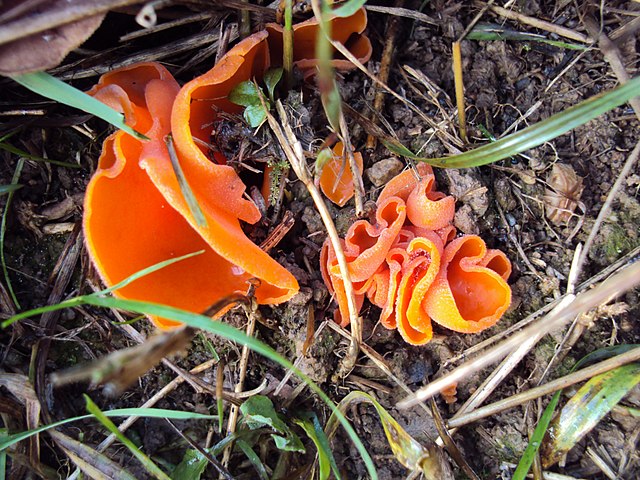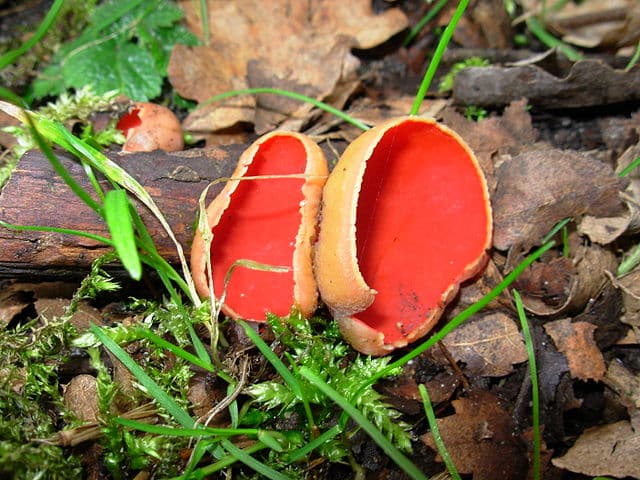
Walk around clearings, forest roads, and even gravel driveways in fall, and you might just run across the orange peel fungus (Aleuria aurantia). It does look very much like a piece of discarded orange peel sitting on the ground, both in color and texture, which makes it easy to overlook. While it isn’t the most choice of edible mushrooms, and no one’s going to be buying it at high prices on the market, it’s still worth a try if you happen to run across it.
Not Actually an Orange Peel
Orange peel fungus is a member of the cup fungi, in the family Pyronemataceae. It most often takes the shape of a wavy, irregularly shaped cup no more than a couple of inches across. Often these grow in clusters, crowding against each other. The texture is a little leathery but brittle, which can make it rather challenging to pick in large quantities. The inside of the cup is generally a bright orange, while the outside is more muted and may have a white, downy texture to it. It does not bruise and like other cup fungi it lacks gills.
This species is quite widespread, though their small size means they’re not always obvious to the casual observer. They are particularly adept at colonizing disturbed soil, which means they like clearcuts and logging roads in forests, but also happily show up along sidewalks, in yards or meadows. Sometimes they’ll pop up in mulch and woodchips as well. They tend to fruit in fall, though they may appear other times of year; the spores lack color.

A Few Lookalikes To Avoid
Thankfully this distinctive mushroom doesn’t have much in the way of dangerous lookalikes. Sowerbyella rhenana looks very similar, but both the inside and outside of the cups are bright orange, rather than orange peel fungus’ paler outside. Caloscypha fulgens is also similar, but bruises a blue-green. Sarcoscypha coccinea is a deeper red color, and Peziza mushrooms tend to be more brown, while Otidea species appear more erect and not as floppy. None of these lookalikes are deadly if consumed, but avoid eating them anyway for your safety.
Eating Orange Peel Fungus
There’s no way around it: this is not the most exciting of edible fungi, and many people will just pass it by. But if you are a determined forager who wants to sample as many species as possible, it’s worth giving it a try, though it doesn’t have much in the way of flavor of its own. You’ll want to cook it thoroughly as it can be quite tough, and if you collect more than you need it can be preserved through dehydration. Often it is valued for its ability to add a splash of color to otherwise boring-looking dishes.
You’re also going to need to be patient as you need a lot of these to add up to any substantial amount. Since they may not grow in huge patches, picking them may seem like a waste of time. Give them a try anyway; you might like them in a mixed mushroom dish, or as a quick snack when sauteed in butter or oil.
—————
Written by Rebecca Lexa
Rebecca Lexa is a certified Master Naturalist in the Pacific Northwest. She teaches classes on foraging and other natural history topics, both online and off. More about her work can be found at http://www.rebeccalexa.com.
Many of our readers find that subscribing to Eat The Planet is the best way to make sure they don't miss any of our valuable information about wild edibles.
See our privacy policy for more information about ads on this site







One Response
I found a large patch of these last week where many of them were larger than I had previously seen. It was at the end of a logging road where logs had been gathered, so there was an abundance of wood chips covering the gravel. This allowed me to easily collect a couple of pounds without getting dirt. We fried some and I thought they were really good, both texture and taste. The rest went into a bechamel sauce where they were one again tasty. I will not pass up a chance to experience this again.
However, I returned to get some more yesterday but lazily chose not to go to the end of the road. Instead I picked the first ones I found, which were smaller on average and growing in gravel. I collected far fewer in twice the time, and they took forever to clean. This could be why these mushrooms don’t have a great reputation.
The complaints about lack of flavour and tough texture are untrue, probably a biased opinion based on selecting poor specimens.